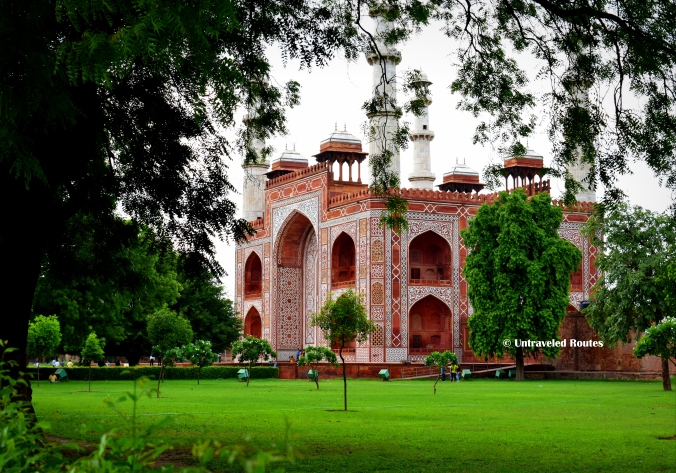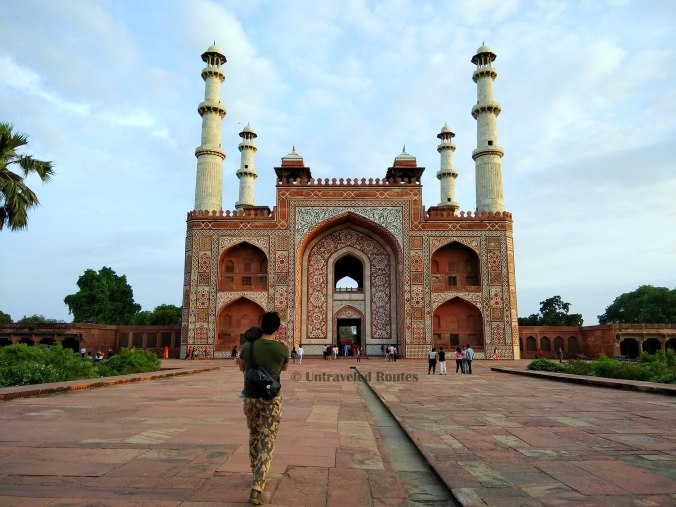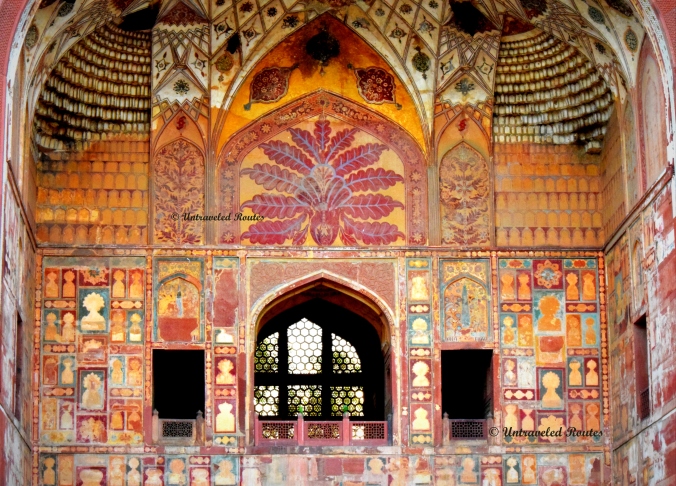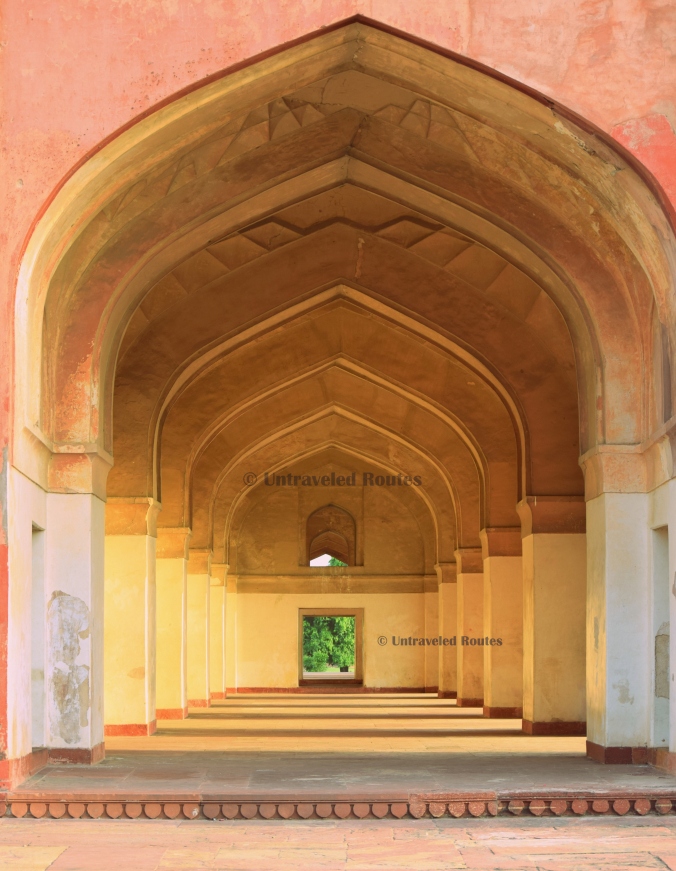Akbar’s Tomb is nestled since time immemorial in Sikandra, Agra. The architectural wonder evokes awe and reverence alike. Akbar’s tomb is an impressive illustration of the art, inspiring in many ways than one – the architecture, design, exquisite inlay work, crafted ceilings and walls decorated with calligraphy, placed beautifully in the huge expanse of 119 acres.
Akbar was buried at Akbar’s Tomb, Sikandra in the mausoleum that was commenced by him while he was alive, and after his death finished by his son and successor, Jahangir in 1613 AD.
The story of history of Agra and it’s connection to Mughal Empire in India is incredibly gripping……Let’s rediscover together.
The ancient city (Agra) is referred to as ‘Agraban’ in Mahabharata, one of the two major Sanskrit epics of ancient India; And the other one identified as modern city, which was founded in 1558 AD.

The main entrance to Akbar’s Tomb in Sikandra. The Architecture is awe-inspiring, it left me wondering in that era such amazing work of art and architecture was created by humans! It’s impossible to replicate or even make something remotely similar reflecting this epitome of beauty and strength.
The Name – Sikandra!
Sultan Sikandar Lodi rebuilt Agra in 1505 AD and made it the seat of the Government. A few miles from Agra there is a village named after Sultan – Sikandra! Ibrahim Lodi, son of Sikandar Lodi, was defeated and slain by Babar at the ‘Battle of Panipat’, near Delhi, in 1526 AD. And thus began the reign of the Mughal Empire that lasted till 18th century (until the time India was gripped by British Raj).
The Era of Akbar the Great
Akbar, the third Mughal Emperor, was born on 15 October, 1542 to Humayun and Hamida Begum at Umerkot in Sindh (now part of Pakistan). Akbar-e-Azam (Abu’l-Fath Jalal-ud-din Muhammad Akbar) was enthroned as emperor at a tender age of 13 on February 14, 1556. He succeeded Humayun and proved to be one of the greatest rulers of the Mughal dynasty in India. Under Akbar’s reign which lasted from 11 February, 1556 to 27 October, 1605 for 49 years, the Mughal Empire tripled in wealth and influence.


Akbar, is admired for lot of things, for instance Akbar could neither read nor write but that did not stop him from having a great library of over 24,000 volumes spanning across Hindi, Sanskrit, Persian, Arabic, Greek, Latin and Arabic and every book was read through to him from beginning to end. Akbar had remarkably open-minded attitude and invited several missions of Jesuit priests to his court, to learn more about Christian faith and to debate with representatives of Islam and other faiths. Akbar believed that all humankind constitutes a single brotherhood, created by the same God, and fundamentally equal before Him.
A detailed and minute account of Akbar’s life is captured in ‘Akbar-nama’, written by Akbar’s devoted friend Abul Fazl.

Akbar’s cenotaph inside the mausoleum

The Circumferential Gallery that surrounds the Tomb, observe the geometric impressions on ceiling and the perfection in architecture is so evident



The intricate designs adorned with beautiful colors, a lot of it has worn away over the time but I’m happy to see whatever is preserved of this wonder.
Akbar died in the Fort at Agra on October 13, 1605, in the fifty-first year of his reign, aged 63.

This one right here is my favorite picture – I call it ‘Window to the Heart’!!
Akbar, the great emperor, still lives in stories and one can’t stop getting engulfed in the fascinating history of his rule.
Till the next post, Happy Travels 🙂


Oh Charu …. this was so fascinating and the pictures so exquisite I feel as though I need to go and lie down with my eyes shut and just let my mind slowly assimilate and absorb. That place …. it surely is perfect. The detail, the colour, the wonderful gracious lines inside and out. And I share your delight in your ‘window to the heart’ … simply divine. Thank you so much for this. It really was the tonic I needed today when feeling a little drained and down – now I feel revived and amazed and quite in awe of what humans can achieve if they have a mind to. 💛
LikeLiked by 2 people
I totally share your thoughts 🙂 When I saw this place for the first time, I felt like being transported to that era of Mughals. The architecture and the history that surrounds this Tomb is so absorbing. I’m glad I could take a little burden off and help you refresh. Thank you so much for your feedback,
LikeLiked by 1 person
It’s always a pleasure to remark on your posts – the beautiful photography and the fascinating facts and your knack of bringing a place into my space is wonderful 🙂
LikeLiked by 1 person
Wow! Thank you. Thank you. Thank you my dear 🙂
LikeLiked by 1 person
Thank you, Charu, for another remarkable post on Agra, its cultural heritage and its history. The images give fascinating testimony to India’s cultural greatness. Now I know why Alexander the Great wanted to march with his army to India. Even then India’s fame must have spread all the way to Macedonia.
LikeLiked by 1 person
Your words are so encouraging! I’m glad I could do justice to the architectural wonder. Thank you for bringing in that ‘Alexander’ perspective. 🙂
LikeLiked by 1 person
I have been to Agra many times but never visited this place probably because it is outside the city.
LikeLiked by 1 person
It’s very far though next time when you visit may be you can try 🙂
LikeLiked by 1 person
Typo, I meant NOT very far….
LikeLike
It’s on my mind…let’s see if it works out. 🙂
LikeLiked by 1 person
Such beautiful pics…The place looks so calm and serene.
LikeLiked by 1 person
Thank you ! It indeed has calming effect 🙂
LikeLiked by 1 person
Thank you Charu for sharing your amazing pictures and historical facts. I’ve been in Agra last year, but regret not having seen this beautiful Tomb. Well I saw the famous Taj Mahal, yet wasn’t that impressed as what the touristic world craves to see. A place this temple would have been more interesting to me.
LikeLiked by 1 person
How kind of you to say that! Thank you for the appreciation☺️ Actually, everyone who visits Agra is tempted to visit the Taj Mahal, as it is touted as wonder and has now become really popular. In fact, when I was in Agra, the first thing I wanted to see was Taj only. As we explored the city, other wonders came into limelight. Akbar’s Tomb is one of them. I’m glad I could do justice to it. There are others which I will cover in future like the Fatehpur Sikri ☺️☺️ Thank you for your feedback.
LikeLike
Charu, how kind of you for your feedback.
LikeLiked by 1 person
Amazing pics. Loved the post.
LikeLike
Thank you friend ☺️☺️
LikeLiked by 1 person
Wow, these are beautiful pictures. I’m glad I found a talented photographer to follow on WordPress!
LikeLiked by 1 person
That’s so kind of you! Thank you for the encouragement 🙂
LikeLiked by 1 person
Amazing pictures! I hadn’t heard about Sikandra before but this post has made me add it to my list! I love the fact that care has been taken to ensure the beautiful symmetry comes through the pictures 🙂
Cheers!
LikeLiked by 1 person
Thank you! Thank you! I’m so happy I could interest you in this 🙂 Appreciate your keen observation of the symmetry 🙂
Cheers to Travel!
LikeLiked by 1 person
I have been to Agra long time ago ….. I don’t remember visiting Akbar’s tomb. So post your post, it has been added to the Agra itinerary 🙂 Charu, you have captured the beauty of the structure so well. There is so much symmetry in its architecture and the main darwaaza with its colorful alcove is such a beauty!
LikeLiked by 1 person
Wow! Thank you so much, that means a lot ☺️☺️ I’m glad I could make it so interesting!! The architecture is just so engaging here, I’m yet to cover Fatehpur Sikhism.. That is also one of the beautiful places in Agra
LikeLiked by 1 person
I ve been to Fatehpur Sikri, Jjodha Mahal, Agra Fort & Taj Mahal. Waiting for the restoration work to get over (Taj Mahal) so that I can revisit these places.
LikeLiked by 1 person
Mughal architecture at its best 🙂
https://deepakacharya.wordpress.com/
LikeLiked by 1 person
Thank you Deepak! 🙂
LikeLiked by 1 person
Oh, Charu, the architecture of Akbar’s Tomb is impressive. Thank you for sharing the history, and the excellent photos.!
LikeLike
Thank you Miriam! I’m glad it interests you 🙂🙂
LikeLiked by 1 person
You’re welcome. Yes, it’s interesting.
LikeLiked by 1 person
I can’t even imagine how amazing it must feel standing there. Being there. Thank You for sharing!
LikeLiked by 1 person
Thank you friend ☺️ To be there is just an amazing feeling like being transported to a different Era of Art and Culture!!
LikeLike
Gorgeous photos! Did I tell you I have a hung for symmetry 😉
LikeLiked by 1 person
Thank you Bipasha🙂 Yeah, I can say that there’s something about the symmetry💛 it makes me excited too.
LikeLiked by 1 person
Really love the pictures and the history! Why don’t you consider posting them on the National Geographic Your Shot community? It’s a great platform for budding photographers to collaborate. And you would definitely receive tons of likes for your amazing pictures!
LikeLiked by 1 person
Wow! That is really kind of you 🙂 Such encouragement keeps us going….
I will check the Nat Geo forum for sure, in fact I remember going through it once earlier, they have some limitations on the picture size, DPI and all.
LikeLiked by 1 person
The pictures are really amazing.
I have been there as a child, although I hardly remember anything.
Glad that you are sharing these monumental heritages with the world.
How have you been Charu ? I have been so occupied with exams and stuff, I haven’t been able to reach out to my WordPress fam.
I hope things are well on your end.
LikeLiked by 1 person
Hi Tajwar,
I’m so glad to see you back 🙂🙂 and happy to know that I could add a smile to your face and bring back memories. Thank you!! All well, things go up and down, that’s Life ☺️
LikeLike
Such architecture.
LikeLiked by 1 person
Thank you guys! 🙂
LikeLiked by 1 person
🙂
LikeLiked by 1 person
A beautiful place!
LikeLiked by 1 person
Beautiful photographs and such awesome displays of respect for more than ourselves. 🕊
The antiquity’s are fascinating. . . Thank you for taking us along. Smiles, Robin 💐
LikeLiked by 1 person
Pingback: Why Mughals had Harem Quarters? | Untraveled Routes
Stunning architecture!
LikeLiked by 1 person
Beautiful! I recently read Ruler of the World which is a book about Akbar! So amazing to see these photos!
LikeLike
Thank you!! So glad you found it interesting, more so as you could relate to it after reading the book ☺️☺️ hope you do come back for reading more of stories.
LikeLike
Sure will:)
LikeLike
☺️☺️
LikeLike
A great place to know about Akbar and I learn about him and enjoyed a lot over there. This is place worth remembering and the photographs you clicked are great.
LikeLiked by 1 person
Thank you Nitesh, I’m very glad that the post brings back happy memories and you like the pictures 🙂
LikeLiked by 1 person
Pingback: The Legend of Jamali-Kamali | Untraveled Routes